SUBHEAD: Are we about to enter an age of chaos and collapse that will dwarf all the dark ages in our past?
By Albert Bates on 02 November 2009 in Culture Change -
http://www.culturechange.org/cms/index.php?option=com_content&task=view&id=541&Itemid=1

Image above: Graphic celebrating Mexico's Day of the Dead. From http://images.google.com/imgres?imgurl=http://www.volumeone.com/products/images/dayofdead.jpg
The great advantage we have, our best chance for avoiding the fate of past societies, is that we know about those past societies. We can see how and why they went wrong. Humankind has the information to know itself for what it is: an Ice Age hunter only half-evolved towards intelligence; clever but seldom wise.
"We are now at the stage when the Easter Islanders could still have halted the senseless cutting and carving, could have gathered the last trees’ seeds to plant out of reach of the rats. We have the tools and the means to share resources, clean up pollution, dispense basic health care and birth control, set economic limits in line with natural ones.
If we don’t do these things now, while we prosper, we will never be able to do them when times get hard. Our fate will twist out of our hands. And this new century will not grow very old before we enter an age of chaos and collapse that will dwarf all the dark ages in our past." - Ronald Wright, A Short History of Progress (2004)
Late October’s stock market crash was forecast so broadly that anyone who was surprised by it has not been noticing. Those green shoots the government was jiving about in the Spring did not yield fruit, and now comes the Winter of Great Discontent.
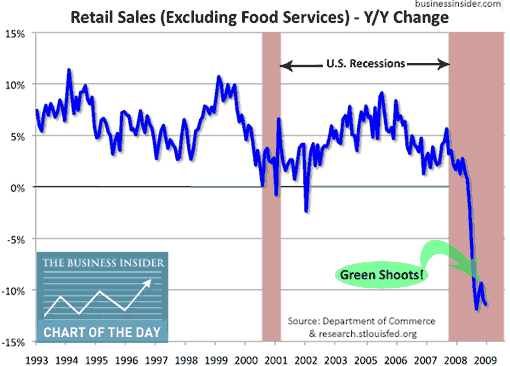
We are still being told this will not be an “L” shaped depression, but don’t believe it. The shape is more like a long back-slash, pixel-bit-mapped by resting steps. If you back down the enlargement, it smoothes. Enjoy the slide. Like us, you may find you have more time on your hands.
We have been skipping more conferences than we have been attending lately, and fortunately for us, those meetings have been getting more web-savvy and posting the presentations for the non-attendee audience. That used to mean not getting to hear the illuminating conversations that happened around the coffee urn, or in sponsored hotel suites and piano bars, but even that part is now being web-cast.
See, for instance, the conversation <theautomaticearth.blogspot.com> between Euan Mearns and Rembrant Loppelaar, of The Oil Drum: Europe, <europe.theoildrum.com> and Stoneleigh, of The Automatic Earth <theautomaticearth.blogspot.com> as they un-jet-lagged in the Rocky Mountains National Park in the run-up to the ASPO meeting in Denver <peakoil.net>. We could call ourselves a fly-on-the-wall, but from the photo, there was way much too much snow for that.
Speaking of flies, here in Mexico it is very, very quiet. This past weekend the children were all in Halloween costumes and parties and parades for the Day of the Dead were temporarily festive, but now it is Sunday morning, and the quiet has returned. Calling up ghosts, the newspaper Por Esto! <poresto.net> daily reports the number of people getting off airplanes in Cancun and Acapulco and the numbers of flight cancellations. Numbers, what numbers? It’s a cargo-cult for the vanishing tourism industry. Fewer than twenty percent of the hotels and restaurants in this part of the Mayan Riviera are even bothering to open.
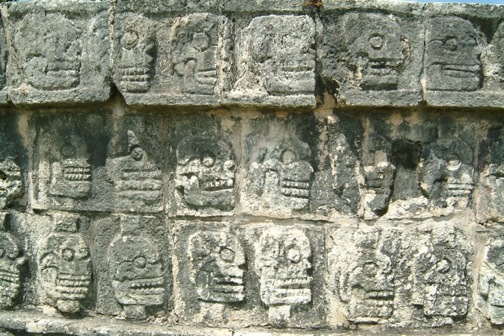
The Diebold presidente here, Felipe Calderón, proposes to privatize the national oil company, Pemex. The elected but excluded actual presidente, Andres Manuel Lopez Obrador, with his pot-bagging street crowds, controls enough of the national assembly to thwart that move, but the seriousness of the proposal exemplifies the degree of official desperation.
The largest single source of both national exports and government tax revenues is the state-owned oil and gas resource, which is in production free-fall after desperate attempts at tertiary recovery using nitrogen injection and lateral drilling. Mexico is the US’s third largest supplier, in case we had forgotten.
With the tax base falling, services are being curtailed at all levels, business taxes have tripled in six months, there are rolling blackouts and brownouts every day, the peso has slid and the price of food (most of it now imported) has skyrocketed. On January 1, 2010, the federal government will raise the price of gasoline, diesel, electricity and LP and LNG gas by 17%. It will also levy a “holding tax” on any bank deposit of 3% per year on everything over $1500. That comes on top of a 16% addition to the VAT.
This week they came with trucks and stopped at city halls in rural towns and gave out rice, beans, and corn flour for anyone who needed it. This is normally something they do after a hurricane. The hurricane now is economic. The government doesn't like people banging pots.
Mexico is getting hit with a triple whammy — its other two largest sources of income are remittances (which are down and people are returning from the north in search of employment) and tourism (which is being killed by the swine flu and violent crime rumors, both overblown, and by the financial belt-tightening upstream where tourists are begat — the US, EU, and Japan).
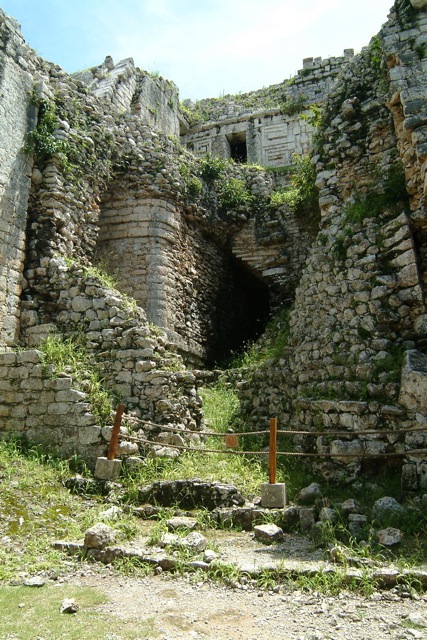
Calderón’s solution to privatize Pemex is not even so much a proposal as a bullying threat. It would mean Mexico would not get $86 billion/yr in oil revenues to run the government, but it would get a one-time purchase price, and the government could run on that until Calderón leaves office.
Seriously, that's the president’s plan. It only amazes us that no-one in the US is considering doing what an earlier presidente of Mexico, Lazaro Cardénas, <peaksurfer.blogspot.com> did, which was to nationalize the oil companies. Since 2007, Exxon’s profits alone could have gone a long way towards balancing the deficit. Instead, they are being squandered on high-priced condos in Dubai with 50-meter private boat docks that spell out Koranic verses that can be viewed by orbiting billionaires.
Rather than nationalize the oil companies, the US jumped off on Afghanistan to take back its poppy trade, which had been successfully eradicated in the 1990s by the Islamic fundamentalist local Talibans, despite the CIA’s best efforts. That is really the only reason the Western Alliance is in Afghanistan. We watched Joe Biden listening to “God Bless America” being played at the seventh inning stretch during the third game of the World Series and we wondered, does he know?

Is that why our Nobel Peace Prize-winning Shogun is raining hellfire missiles on Pakistan’s tribal territories from predator drones controlled from windowless buildings in Las Vegas — a completely outlaw move under international treaties going back two centuries — to take back control of our former guys (they are called Al Qaeda) from the Koran-readers? To ramp that production back up? The heroin trade envoys — largely private contractors — have been doing spectacularly well at their assigned mission, despite the blow-back from the human rights community. Afghani Brown <newsmeat.com> is now ratcheting up close its earlier production records. The Opium Empire is secure, or at least so it might appear to the heir of Kissinger’s Nobel House.
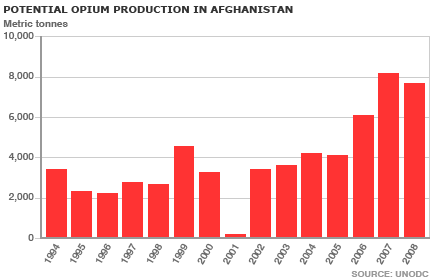
Unfortunately, whether it is poppies or tulips, the global economy had other plans. It was overdue for correction, and Peak Everything was both the trigger and the bullet through its brain. We are in a civilization collapse of unprecedented proportions now: Joseph Tainter and Jared Diamond cubed; the Club of Rome on steroids.
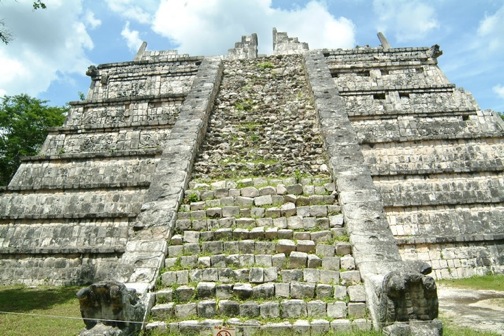
Here in the Yucatán they still speak Yukatek, and the local government, at its incense-burning base, is managed by a class of white shamans, who call themselves that formally, and cleave to many of the rituals that have remained in these parts since the Ah Itzá left, including the occasional ayahuasca ceremony to communicate with the spirit world and cleanse demons. Dia de los Muertos is all about that.
Historically the Itzá were a fierce Mesoamerican people who remained in the Yucatán long after other Mayan dynasties collapsed. In the classic period they erected the cities around Tikal near lake Peten Itzá in Guatemala, then abandoned those to migrate north into the Yucatán during the classic period collapse. From their new capital at Chichén Itzá, which resembles Tikal in its monumental architecture arranged as an astronomical calendar, they established a sail-powered trade empire reaching as far south as Honduras. Collapse? What collapse?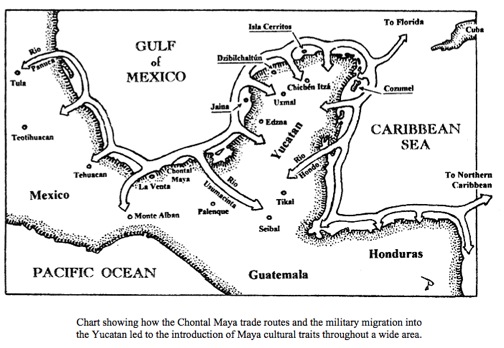
Eventually the Itzá got sacked in a power struggle between three Yucatekan lineages all claiming to have descended from the Toltecs. The Itzá said that dark sorcery was at work in their defeat and these local governments of white shamans are making sure that won’t happen again. In 1331 the Itzá royal lineage abandoned Chichén Itzá and returned south to the Petén, constructing a new fortress city, Noh Petén (also called Tah Itzá or Tayasal), on an island in the middle of Lake Peten Itzá, today part of Guatemala, near the western border of Belize.
There they successfully resisted many military expeditions by the Spanish until finally surrendering in 1697 to a diplomatic delegation led by Martín de Ursua, governor of Yucatán. The terms of surrender allowed them to retain the Mayan shamanic culture that continues today.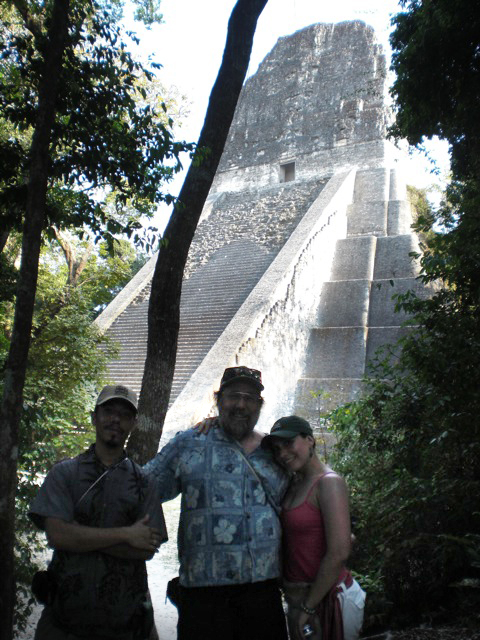
To the Maya the oil that seeped from the ground was useful for tarring canoes and sailing craft, but little else. It was too stinky and smoky to burn for heat or light, and you couldn’t eat it.
Their black gold was soil, and the milpa system still practiced in the Petén and elsewhere, with chinampas<en.wikipedia.org>; the black earths within the pyramid city walls attest to their skill as scientific soil-builders. They had learned the hard way what happens when you cut your trees to roast lime and let the good soil run off the land. By changing their soil management practices, they had improved their diet, moderated their climate, and changed their fortunes.
When we glance at the downloadable audio files and powerpoints from another meeting, “4 Degrees and Beyond” held September 28-30 in Oxford, England, <eci.ox.ac.uk> we can easily see that once humans break through the 2°C striped yellow caution tape, tacked up by the EU a few years ago, we’ll enter what the Potsdam Institute <eci.ox.ac.uk> now calls Terra Quasi-Incognita, complete with sea levels rising back to the Oligocene (+100m), a 90% population die-off, and tipping points that could take us to Venus.
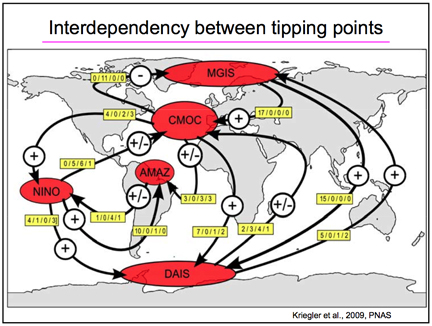
Standing along the path to Copenhagen, offering handfuls of soil to the passing delegates, are the Yucatán shamans.
* * * * *
Albert Bates is a permaculture and appropriate technology instructor at the Ecovillage Training Center (thefarm.org/etc) in Summertown,Tennessee and in rural Mexico and Belize. He will next be teaching a full Permaculture Design Course at the Maya Mountain Research Center in Belize <mmrfbz.org> in March 2010 after he returns from Copenhagen, where he will attend the climate talks as a UN representative for the Global Ecovillage Network. His next book, The Tao of Biochar, will be published by New Society in 2010. Albert blogs at peaksurfer.blogspot.com. See Culture Change articles by or on Albert at <culturechange.org>
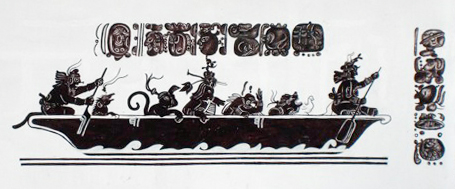
.
By Albert Bates on 02 November 2009 in Culture Change -
http://www.culturechange.org/cms/index.php?option=com_content&task=view&id=541&Itemid=1

Image above: Graphic celebrating Mexico's Day of the Dead. From http://images.google.com/imgres?imgurl=http://www.volumeone.com/products/images/dayofdead.jpg
The great advantage we have, our best chance for avoiding the fate of past societies, is that we know about those past societies. We can see how and why they went wrong. Humankind has the information to know itself for what it is: an Ice Age hunter only half-evolved towards intelligence; clever but seldom wise.
"We are now at the stage when the Easter Islanders could still have halted the senseless cutting and carving, could have gathered the last trees’ seeds to plant out of reach of the rats. We have the tools and the means to share resources, clean up pollution, dispense basic health care and birth control, set economic limits in line with natural ones.
If we don’t do these things now, while we prosper, we will never be able to do them when times get hard. Our fate will twist out of our hands. And this new century will not grow very old before we enter an age of chaos and collapse that will dwarf all the dark ages in our past." - Ronald Wright, A Short History of Progress (2004)
Late October’s stock market crash was forecast so broadly that anyone who was surprised by it has not been noticing. Those green shoots the government was jiving about in the Spring did not yield fruit, and now comes the Winter of Great Discontent.

We are still being told this will not be an “L” shaped depression, but don’t believe it. The shape is more like a long back-slash, pixel-bit-mapped by resting steps. If you back down the enlargement, it smoothes. Enjoy the slide. Like us, you may find you have more time on your hands.
We have been skipping more conferences than we have been attending lately, and fortunately for us, those meetings have been getting more web-savvy and posting the presentations for the non-attendee audience. That used to mean not getting to hear the illuminating conversations that happened around the coffee urn, or in sponsored hotel suites and piano bars, but even that part is now being web-cast.
See, for instance, the conversation <theautomaticearth.blogspot.com> between Euan Mearns and Rembrant Loppelaar, of The Oil Drum: Europe, <europe.theoildrum.com> and Stoneleigh, of The Automatic Earth <theautomaticearth.blogspot.com> as they un-jet-lagged in the Rocky Mountains National Park in the run-up to the ASPO meeting in Denver <peakoil.net>. We could call ourselves a fly-on-the-wall, but from the photo, there was way much too much snow for that.
Speaking of flies, here in Mexico it is very, very quiet. This past weekend the children were all in Halloween costumes and parties and parades for the Day of the Dead were temporarily festive, but now it is Sunday morning, and the quiet has returned. Calling up ghosts, the newspaper Por Esto! <poresto.net> daily reports the number of people getting off airplanes in Cancun and Acapulco and the numbers of flight cancellations. Numbers, what numbers? It’s a cargo-cult for the vanishing tourism industry. Fewer than twenty percent of the hotels and restaurants in this part of the Mayan Riviera are even bothering to open.

The Diebold presidente here, Felipe Calderón, proposes to privatize the national oil company, Pemex. The elected but excluded actual presidente, Andres Manuel Lopez Obrador, with his pot-bagging street crowds, controls enough of the national assembly to thwart that move, but the seriousness of the proposal exemplifies the degree of official desperation.
The largest single source of both national exports and government tax revenues is the state-owned oil and gas resource, which is in production free-fall after desperate attempts at tertiary recovery using nitrogen injection and lateral drilling. Mexico is the US’s third largest supplier, in case we had forgotten.
With the tax base falling, services are being curtailed at all levels, business taxes have tripled in six months, there are rolling blackouts and brownouts every day, the peso has slid and the price of food (most of it now imported) has skyrocketed. On January 1, 2010, the federal government will raise the price of gasoline, diesel, electricity and LP and LNG gas by 17%. It will also levy a “holding tax” on any bank deposit of 3% per year on everything over $1500. That comes on top of a 16% addition to the VAT.
This week they came with trucks and stopped at city halls in rural towns and gave out rice, beans, and corn flour for anyone who needed it. This is normally something they do after a hurricane. The hurricane now is economic. The government doesn't like people banging pots.
Mexico is getting hit with a triple whammy — its other two largest sources of income are remittances (which are down and people are returning from the north in search of employment) and tourism (which is being killed by the swine flu and violent crime rumors, both overblown, and by the financial belt-tightening upstream where tourists are begat — the US, EU, and Japan).

Calderón’s solution to privatize Pemex is not even so much a proposal as a bullying threat. It would mean Mexico would not get $86 billion/yr in oil revenues to run the government, but it would get a one-time purchase price, and the government could run on that until Calderón leaves office.
Seriously, that's the president’s plan. It only amazes us that no-one in the US is considering doing what an earlier presidente of Mexico, Lazaro Cardénas, <peaksurfer.blogspot.com> did, which was to nationalize the oil companies. Since 2007, Exxon’s profits alone could have gone a long way towards balancing the deficit. Instead, they are being squandered on high-priced condos in Dubai with 50-meter private boat docks that spell out Koranic verses that can be viewed by orbiting billionaires.
Rather than nationalize the oil companies, the US jumped off on Afghanistan to take back its poppy trade, which had been successfully eradicated in the 1990s by the Islamic fundamentalist local Talibans, despite the CIA’s best efforts. That is really the only reason the Western Alliance is in Afghanistan. We watched Joe Biden listening to “God Bless America” being played at the seventh inning stretch during the third game of the World Series and we wondered, does he know?

Is that why our Nobel Peace Prize-winning Shogun is raining hellfire missiles on Pakistan’s tribal territories from predator drones controlled from windowless buildings in Las Vegas — a completely outlaw move under international treaties going back two centuries — to take back control of our former guys (they are called Al Qaeda) from the Koran-readers? To ramp that production back up? The heroin trade envoys — largely private contractors — have been doing spectacularly well at their assigned mission, despite the blow-back from the human rights community. Afghani Brown <newsmeat.com> is now ratcheting up close its earlier production records. The Opium Empire is secure, or at least so it might appear to the heir of Kissinger’s Nobel House.

Unfortunately, whether it is poppies or tulips, the global economy had other plans. It was overdue for correction, and Peak Everything was both the trigger and the bullet through its brain. We are in a civilization collapse of unprecedented proportions now: Joseph Tainter and Jared Diamond cubed; the Club of Rome on steroids.

Here in the Yucatán they still speak Yukatek, and the local government, at its incense-burning base, is managed by a class of white shamans, who call themselves that formally, and cleave to many of the rituals that have remained in these parts since the Ah Itzá left, including the occasional ayahuasca ceremony to communicate with the spirit world and cleanse demons. Dia de los Muertos is all about that.
Historically the Itzá were a fierce Mesoamerican people who remained in the Yucatán long after other Mayan dynasties collapsed. In the classic period they erected the cities around Tikal near lake Peten Itzá in Guatemala, then abandoned those to migrate north into the Yucatán during the classic period collapse. From their new capital at Chichén Itzá, which resembles Tikal in its monumental architecture arranged as an astronomical calendar, they established a sail-powered trade empire reaching as far south as Honduras. Collapse? What collapse?

Eventually the Itzá got sacked in a power struggle between three Yucatekan lineages all claiming to have descended from the Toltecs. The Itzá said that dark sorcery was at work in their defeat and these local governments of white shamans are making sure that won’t happen again. In 1331 the Itzá royal lineage abandoned Chichén Itzá and returned south to the Petén, constructing a new fortress city, Noh Petén (also called Tah Itzá or Tayasal), on an island in the middle of Lake Peten Itzá, today part of Guatemala, near the western border of Belize.
There they successfully resisted many military expeditions by the Spanish until finally surrendering in 1697 to a diplomatic delegation led by Martín de Ursua, governor of Yucatán. The terms of surrender allowed them to retain the Mayan shamanic culture that continues today.

To the Maya the oil that seeped from the ground was useful for tarring canoes and sailing craft, but little else. It was too stinky and smoky to burn for heat or light, and you couldn’t eat it.
Their black gold was soil, and the milpa system still practiced in the Petén and elsewhere, with chinampas<en.wikipedia.org>; the black earths within the pyramid city walls attest to their skill as scientific soil-builders. They had learned the hard way what happens when you cut your trees to roast lime and let the good soil run off the land. By changing their soil management practices, they had improved their diet, moderated their climate, and changed their fortunes.
When we glance at the downloadable audio files and powerpoints from another meeting, “4 Degrees and Beyond” held September 28-30 in Oxford, England, <eci.ox.ac.uk> we can easily see that once humans break through the 2°C striped yellow caution tape, tacked up by the EU a few years ago, we’ll enter what the Potsdam Institute <eci.ox.ac.uk> now calls Terra Quasi-Incognita, complete with sea levels rising back to the Oligocene (+100m), a 90% population die-off, and tipping points that could take us to Venus.

Standing along the path to Copenhagen, offering handfuls of soil to the passing delegates, are the Yucatán shamans.
* * * * *
Albert Bates is a permaculture and appropriate technology instructor at the Ecovillage Training Center (thefarm.org/etc) in Summertown,Tennessee and in rural Mexico and Belize. He will next be teaching a full Permaculture Design Course at the Maya Mountain Research Center in Belize <mmrfbz.org> in March 2010 after he returns from Copenhagen, where he will attend the climate talks as a UN representative for the Global Ecovillage Network. His next book, The Tao of Biochar, will be published by New Society in 2010. Albert blogs at peaksurfer.blogspot.com. See Culture Change articles by or on Albert at <culturechange.org>

.
No comments :
Post a Comment